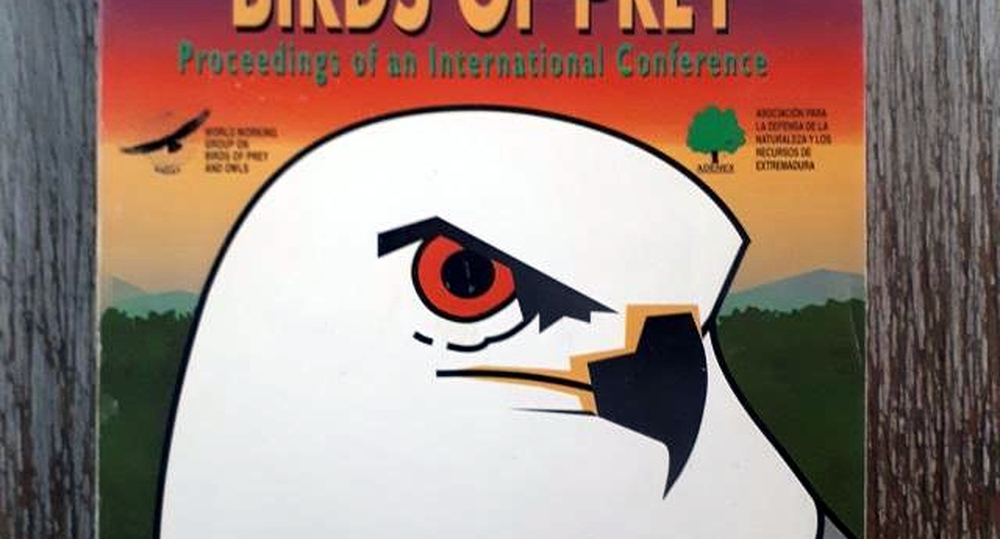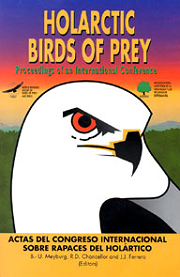
Holarctic Birds of Prey (1998) papers

This volume comprises the proceedings of the International Conference on Holarctic Birds of Prey and Owls held by WWGBP in conjunction with the Spanish nature conservation organisation ADENEX in April 1995 at Badajoz, Extremadura, Spain and attended by over 400 ornithologists. The volume contains 680 pages, with 59 original papers.
Titles include Migration Patterns in West Palaearctic Raptors, Utility Structures as Mortality Factor for raptors and owls, Census Techniques for Birds of Prey in Large Areas, Electrical Transmission Pylons as Nesting Sites used by Kestrels, Organochlorine P esticides, PCBs & Mercury in Osprey eggs, Morphometric Features characterising Flight Properties of Palaearctic Eagles, Molecular Systematics of Holarctic Raptors, Dependence and Emancipation in Juvenile Marsh Harriers, Captive Breeding and Releases of Peregrines in North America, Phylogenetic Relationships in Holarctic Owls, Use of Logistic Regression Models to Predict Consumption of carcasses by Griffon Vultures, Toxic Chemicals and Birds of Prey in the mid-1990s, Effects of the Feeding Station Establishment on the Egyptian Vulture in NE Greece, Analysis of the Relation between Land Cover and Golden Eagle Ranging Behaviour, Anti-Poaching at the Straits of Messina, Modelling Establishment of a Reintroduced Population of Griffon Vultures, The Role of the Individual Bird and the Individual Territory in the Population Biology of Sparrowhawks, etc.
Source: The World Working Group on Birds of Prey and Owl.
Downoad papers
Introduction, p 9–26
Part 1. Molecular Systematics of Holarctic Birds of Prey and Owls
Wink M, Seibold I, Lotfikhah F & Bednarek W: Molecular Systematics of Holaretic Raptors (Order Falconiformes), p 29–48
Wink M: Application of DNA-Markers to Study the Ecology and Evolution of Raptors, p 49–71
Heidrich P & Wink M: Phylogenetic Relationships in Holarctic Owls (Order Strigiformes): Evidence from nucleotide sequences of the mitochondrial cytochrome b gene, p 73–87
Part 2. Breeding Biology of Raptors
Bavoux C, Burneleau G, Guillaume PNt, Picard M & Sahuc C: Dependence and Emancipation in Juvenile Marsh Harriers Circus a.aeruginosus, p 91–100
Oleeh B: Population Dynamics and Breeding Performance of the Goshawk Accipiter gentilis in Central Poland in 1982–1994, p 101–110
Ivanovsky VV: Current Status and Breeding Ecology of the Goshawk Aeeipiter gentilis in Northern Belarus, p 111–115
Newton I: The Role of the Individual Bird and the Individual Territory in the Population Biology of Sparrowhawks Accipiter nisus, p 117–129
Avilés J, Sánchez A & Parejo D: Variaciones en Ia Fecha de Puesta de Falco tinnunculus en Extremadura, p 131–140
Krueger Jr, TE: The use of Electrical Transmission Pylons as Nesting Sites by the Kestrel Falco tinnunculus in North-East Italy, p 141–148
Badami A: Breeding Biology and Conservation of Eleonora"s Falcon Falco eleanorae in South-West Sardinia, Italy, p 149–156
Part 3. Biology and Conservation of Diurnal Raptors
Ferrero JJ & Onrubia A: Expansióndelárea de cría y distribución actualdel ElanioAzulElanus caeruleus en España, p 159–171
Gómez-Tejedor H: Comportamiento Cleptoparásito del Milano Real Milvus milvus en un vertedero, p 173–176
Abuladze A: The Bearded Vulture Gypaetus barbatus in Caucasia. p 177–182
Abuladze A & Shergalin J: The Egyptian Vulture Neophron percnopterus in the former USSR, p 183–195
Vlachos C, Papageorgiou NK & Bakaloudis DE (1998): Effects of the Feeding Station Establishment on the Egyptian Vulture Neophron percnopterus in Dadia Forest, North Eastern Greece, p 197–207
Camiña A: Use of Logistic Regression Models to Predict Consumption of Carcasses by Griffon Vultures Gyps fulvus, p 209–213
Guzmán J & Jiménez J: Alimentación del Buitre Negro Aegypius monachus durante los períodos reproductor y post-reproductor en el Parque Nacional de Cabañeros, p 215–221
Gentil A & Ventanas A: Proyecto de Conservación del Buitre Negro Aegypius monachus en la Si-erra de Gata (Cáceres), p 223–229
Galán R, de Andrés AJ & Segovia C: Effects of Forest Fires (1984–92) on the Cinereous Vulture Aegypius monachus reproduction in Sierra Pelada (Huelva, SW España), p 231–238
Galán R, de Andrés AJ & Segovia С: Problems for the Conservation and Measures for the Protection of the Cinereous Vulture Aegypius monachus in Sierra Pelada (Huelva, SW España), p 239–246
Kouzmanov G & Stoyanov G: Sobre la situación actual del Gavilán Griego Accipiter brevipes en Bulgaria, p 247–250
Watson J: Should Golden Eagles Aquila chrysaetos be Food Generalists or Specialists?, p 251–261
McGrady MJ, Grant JG & McLeod DRA: A Preliminary Analysis of the Relation between Land Cover and Golden Eagle Aquila chrysaetos Ranging Behaviour in Argyll, Western Scotland, p 263–270
Gil JM, Molino F & Valenzuela G: Distribución Altitudinal de los Nidos de Águila Real Aquila chrysaetos en Sierra Nevada (sureste de España), p 271–277
Rico L & Martín C: Situación y Problemática del Águila Real Aguila chrysaetos en Alicante, p 279–289
Arroyo B, Ferreiro E & Garza V: Causas de la Regresión del Águila Perdicera Hieraaetus fasciatus en España Central, p 291–304
Fernández A, Román J, de la Torre JA, Ansola JM, Santa Maria J, Ventosa R, Román F & Palma C: Demografía y Conservación de una población de Águila Perdicera Hieraaetus fasciatus en declive, p 305–321
Schmidt D: Osprey Pandion haliaetus breeding numbers in the Western Palearctic, p 323–327
Fuentes C, Munoz del Viejo A & Ruiz de la Concha J: Distribución Espacio-Temporal y Selección de Habitat del Águila Pescadora Pandion haliaetus en las zonas húmedas de la Cuenca Media del Guadiana, p 329–338
Kirmse W: Morphometric features characterizing flight properties of palearctic eagles, p 339–348
García L, Calderón J & Ramo C: Registros poco comunes de Águilas en Doñana y su entorno, p 349–355
Stoyanov G & Kouzmanov G: Nuevos datos sobre la Población del Halcón Sacre Falco cherrug en Bulgaria, p 357–362
Cygan JP: Present Status and Protection of the most endangered Birds of Prey in Poland, p 363–367
Gürsan M: Comparison of past and present Raptor Species Diversity around two Central Anatolian lakes (Turkey), p 369–372
Oliveira LF: Census Techniques for Birds of Prey in large areas of Portugal. Holarctic Birds of Prey, p 373–379
Bevanger K & Overskciug K: Utility Structures as a mortality factor for Raptors and Owls in Norway, p 381–392
Part 4. Supporting Raptor Populations in Danger of Extinction vie Captive Breeding
Frey H & Llopis A: Situación actual del Proyecto de Reintroducción del Quebrantahuesos Gypaetus barbatusen los Alpes, p 395–403
Sarrazin F: Modelling Establishment of a Reintroduced Population of Griffon Vultures Gyps fulvus in Southern France, p 405–416
Tewes E, Terrasse M, Bagnolini C & Sánchez Sánchez Artéz JJ: Captive Breeding of the European Black Vulture Aegypius monachus and the Reintroduction Project in France, p 417–435
Enderson JH, White CM & Banasch U: Captive Breeding and Releases of Peregrines Gyps fulvus in NorthAmerica, p 437–444
Part 5. Biology and Conservation of Holarctic Owls
König C: Ecology and Population of Pygmy Owls Glaucidium passerinum in the Black Forest (SW Germany), p 447–450
Ramos PL & González OJ: Algunos aspectos del gregarismo invernal del Buho Chico Asio otus en la Provincia de Salamanca (España Central), p 451–457
Onrubia A & Jubete F: Status reproductor de la Lechuza Campestre Asio flammeus en España 1993-94, p 459–466
Calvo JM: Alimentación invernal de la Lechuza Campestre Asio flammeus en una localidad del Norte de España, p 467–474
König C: Ecology and Conservation of Tengmalm's Owl Aegolius funereus, p 475–480
Part 6. Raptors: Contamination and Development
Henny CJ: Toxic Chemicals and Bird of Prey in the Mid-1990s: A Personal Perspective, p 483–500
Nygard T & Skaare JU: Organochlorines and Mercury in Eggs of White-tailed Sea Eagles Haliaeetus albicilla in Norway 1974-1994, p 501–524
Henny CJ, Galushin VM & Kuznetsov AV: Organochlorine Pesticides, PCBs, and Mercury in Osprey Pandion haliaetus eggs from the UpperVolga River, Russia, p 525–534
Kenward RE, Pfeffer RH, Bragin EA, Levin A & Newton I: Environmental Contaminants and Movements of Saker Falcons Falco cherrug in Central Asia, p 535–543
Part 7. Socio-economic Aspects of Raptor Conservation
White CM & Kiff LF: Language Use and Misapplied, Selective "Science"; Their Roles in Swaying Public Opinion and Policy as Shown with Two North American Raptors, p 547–560
Oliveira LF: Social and Economic Aspects of Raptor Conservation in Portugal, p 561–574
Hauff P: White-tailed Eagle Haliaeetus albicilla Video Surveillance Project in the nature reserve on the island of Kaninchenwerder, Mecklenburg, Germany, 1993, 1994 and 1995, p 575–580
Part 8. Migratin of Birds of Prey
Bildstein KL: Linking Raptor Migration Science to mainstream Ecology and Conservation: an ambitious agenda for the 21st Century, p 583–601
Newton I: Migration Patterns in West Palearctic Raptors, p 603–612
Griesinger J: Juvenile Dispersion and Migration among Griffon Vultures Gyps fulvus in Spain, p 613–621
Giordano A, Ricciardi D, Candiano G, Celesti S & Irrea A: Anti-Poaching on the Straits of Messina: Results after 15 Years of Activities, p 623–630
Lin WH & Severinghaus LL: Raptor Migration and Conservation in Taiwan, p 631–639
Urcun J-P: The Autumn Migration of Red Kite Milvus milvus through the Pyrenees, p 641–654
Urcun J-P & Bried J: The Autumn Migration of Raptors through the Pyrenees, p 655–680


In order to leave a comment, you need to log in!